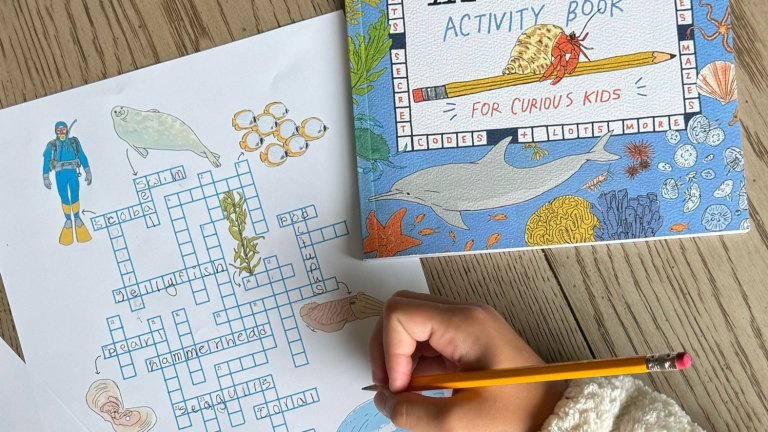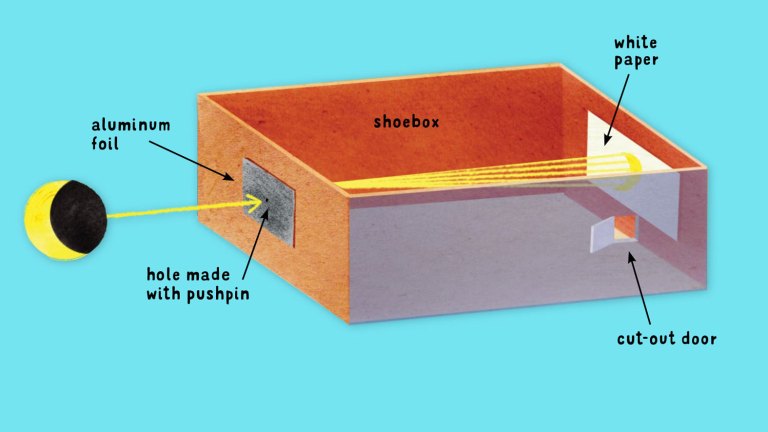A Guide to Eclipses
Don’t miss the solar eclipse! On April 8, 2024, there will be a total solar eclipse in North America. Here’s what you need to know.
Everyone in North America will be able to see at least part of the Sun blocked by the Moon. But along the narrow path of totality—from Mexico, through Texas, to Maine and eastern Canada—folks will see a total solar eclipse.

There, and only there, the Moon will cover the Sun completely. All afternoon, people everywhere will stop, look up, and be amazed. The sky will go completely dark for a few minutes. Birds and animals will prepare for sleep. The Sun’s ghostly corona will appear like a halo around the invisible Sun.
In this article, you’ll learn what causes eclipses, what happens during an eclipse, and how to observe the Sun safely. Wherever you live in North America, you can plan your own eclipse expedition to see this rare and beautiful event. Don’t miss it! The next total solar eclipse to visit all of North America will be in 2045.
How it Looks from Space

What Causes a Solar Eclipse?
A solar eclipse happens when the Moon comes between the Sun and the Earth and completely blocks out the Sun. During a solar eclipse, the shadow of the Moon falls onto the Earth. The dark part of the shadow is called the umbra; the soft, blurry part between the dark and light areas on Earth is the penumbra. Everyone in the umbra sees a total solar eclipse; everyone in the penumbra sees a partial solar eclipse. Anyone outside the path of the Moon’s shadow won’t see an eclipse at all!
Eclipses are visible only on a small part of the Earth. Here are the solar eclipse locations 2021–2041. Yellow paths show where on Earth you can see a total eclipse. Orange paths are annular eclipses. Pink paths are hybrid (part total, part annular).

A total solar eclipse happens somewhere on Earth about every year and a half. Any given place on Earth will have a total solar eclipse every 375 years on average.
Stages of a Solar Eclipse

FIRST CONTACT. The Moon touches the edge of the Sun; partial solar eclipse begins. What can you see?
- Viewed through eclipse glasses, the Sun will look like it has a tiny bite taken out of it.
- It gets darker and colder as the Moon covers more of the Sun.
- You may see shadow bands a few minutes before and after totality (total eclipse). These are wiggly stripes of light and dark that move quickly across the ground. They’re caused by the light of the thin crescent Sun coming through the Earth’s wiggly atmosphere. They are easiest to see on a white sheet, wall, or poster board.
- If you have a clear view of the horizon, you can see the Moon’s shadow rushing across the Earth toward you before the eclipse and away from you after the
- eclipse.

SECOND CONTACT. Beginning of totality: the Moon covers the Sun completely. When you can’t see the Sun through your eclipse glasses, it’s safe to take them off for this period only — and be ready to put them on again soon.
What can you see?
- Just before totality, the diamond ring effect and Baily’s beads — the last bits of sunlight shining between the mountain peaks on the Moon.
- The ghostly corona around the black disk of the Moon. It looks different every eclipse.
- The Sun’s upper atmosphere, called the chromosphere, will be a faint red ring around the Moon.
- Prominences — giant arcs of gas on the Sun’s surface — that look like red loops sticking out of the edge of the Moon.
- Bright stars and planets in a dark sky.
- A “sunset” all the way around the horizon (because it’s dark where you are and light everywhere else).
- Strange animal behavior, such as birds growing quiet. During totality, animals think it’s nighttime!
THIRD CONTACT. End of totality. Put your eclipse glasses back on to protect your eyes.
What can you see?
- The edge of the Sun starts to show. The eclipsed Sun will suddenly be bright again.
- Baily’s beads and the diamond ring appear again, this time on the other edge of the Sun.
- Watch the crescent Sun grow as the Moon moves away.
FOURTH CONTACT. End of partial solar eclipse.
What can you see?
- The entire Sun is visible.
- Birds and animals will behave normally again.
Why Can’t We Look at the Sun?
Looking at the Sun is dangerous because the retina, the light detecting cells at the back of your eye, doesn’t have any nerves that feel pain, so you can damage your eyes without knowing it. Many people believe that the Sun’s rays are even more dangerous during an eclipse. In fact, they are very dangerous for our eyes at all times — but it’s much more tempting to look at the Sun during an eclipse. Never look directly at the Sun, whether there’s an eclipse or not.
Observing the Sun Safely
The only safe way to look at the Sun is to wear eclipse glasses. They have special filters that block out 99.999 percent of the Sun’s light. When you look through them, you should not be able to see anything but the Sun.
It is not safe to view the Sun through things like potato chip bags, DVDs, or smoked glass, no matter what you read on the Internet.
Before using your eclipse glasses, hold your them up to a bright indoor light to look for scratches and holes. If you find any, cut up the glasses and throw them out.
What to Take Eclipse-Watching
Solar eclipses are exciting because they’re rare, and they’re an opportunity for people all over the world to observe together. If this is your first eclipse, don’t take too much fancy equipment. You should spend most of your time watching the eclipse, not trying to get your camera or telescope to work.
Here’s what you must have:
- Eclipse glasses
Other useful items:
- A pinhole projector
- A white sheet or piece of poster board to see shadow bands
- Cool, Cosmic Tattoo Stars and Planets: 50 Temporary Tattoos That Teach
- Snacks and water
- Sunblock and hat
- Watch or phone
- List of eclipse contact times
- Paper and pencil to draw what you observe
- Camera
- Binoculars with solar filters 99.999 percent of the Sun’s light. When you look through them, you should not be able to see anything but the Sun.
Learn More about Eclipses
The following websites are frequently updated and offer a wealth of information and resources.
Excerpted and adapted from Sky Gazing © Meg Thacher.
This captivating book offers a tour of our solar system and deep space, explaining how objects like Earth’s moon were formed and introducing the “why” behind phenomena such as eclipses, northern lights, and meteor showers. Sky gazers will learn how to find and observe planets—no binoculars or telescopes required—and star charts will show them how to spot constellations through the seasons and in both hemispheres.
Activities include tracking the cycles of the sun and moon and observing the sky during daylight hours or on a cloudy night. Includes profiles of professional astronomers and sidebars on space technology and current issues, such as light pollution.










